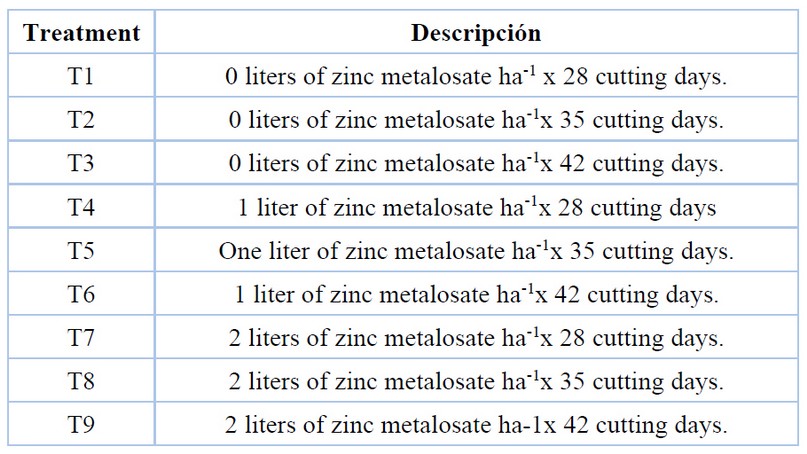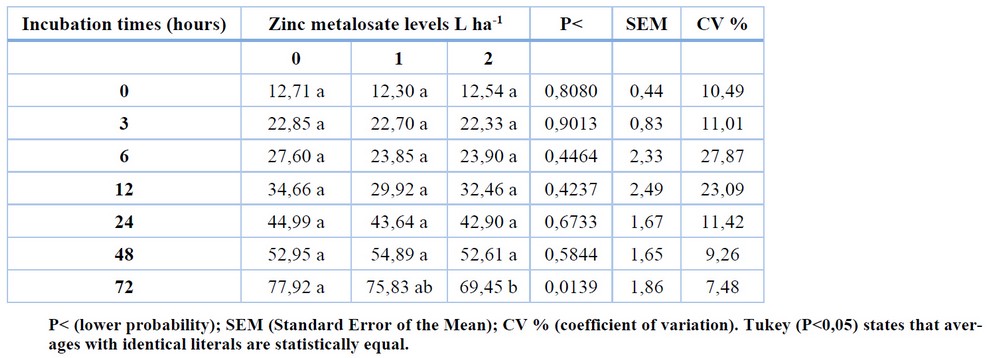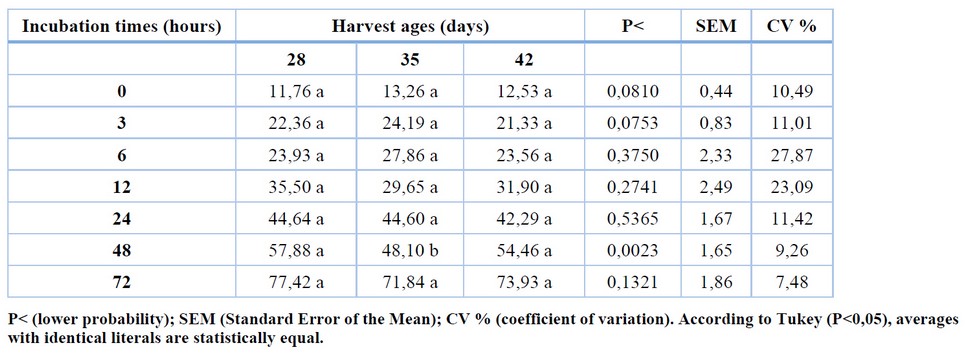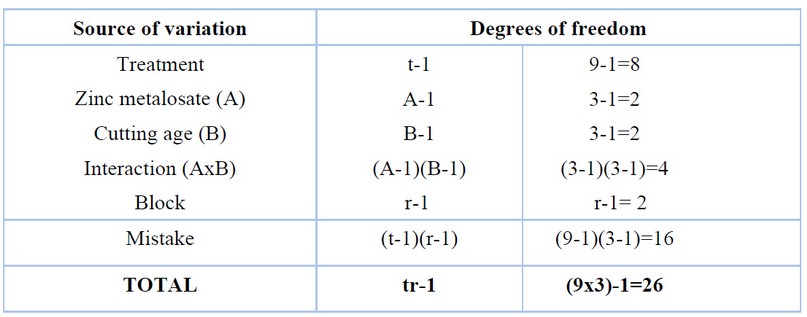2023.08.03.54
Files > Volume 8 > Vol 8 No 3 2023
Protein bioavailability of Panicum maximum cv Mombaza grass under foliar fertilization with zinc metalosate
Pedro Eduardo Nivela Morante 1* , Manuel de Jesús Jumbo Romero 2
, Manuel de Jesús Jumbo Romero 2 , Ramón Raúl Macías Chila 3
, Ramón Raúl Macías Chila 3 , Henrry Othón Intriago Mendoza 4
, Henrry Othón Intriago Mendoza 4 , Amador Javier Suarez Villa 5
, Amador Javier Suarez Villa 5 , Martha Margarita Minaya Macías 6
, Martha Margarita Minaya Macías 6 , Myriam Elizabeth Zambrano Mendoza 7
, Myriam Elizabeth Zambrano Mendoza 7 , Tania Isabel Loor Arauz 8
, Tania Isabel Loor Arauz 8 , Arnaldo Matteo Conforme López 9
, Arnaldo Matteo Conforme López 9 , Eulices Emanuel Loor Giler 10
, Eulices Emanuel Loor Giler 10 and Carlos Quinto García Robles 11
and Carlos Quinto García Robles 11 .
.
1 Universidad Laica Eloy Alfaro de Manabí ; [email protected]
2 Universidad Laica Eloy Alfaro de Manabí ; [email protected]
3 Universidad Laica Eloy Alfaro de Manabí ; [email protected]
4 Universidad Laica Eloy Alfaro de Manabí ; [email protected]
5 Universidad Laica Eloy Alfaro de Manabí ; [email protected]
6 Universidad Laica Eloy Alfaro de Manabí ; [email protected]
7 Universidad Laica Eloy Alfaro de Manabí ; [email protected]
8 Universidad Laica Eloy Alfaro de Manabí ; [email protected]
9 Universidad Laica Eloy Alfaro de Manabí ; [email protected]
10 Universidad Laica Eloy Alfaro de Manabí ; [email protected]
11 Universidad Laica Eloy Alfaro de Manabí ; [email protected]
* Correspondence: [email protected]; Tel.: (+593 998426187)
Available from: http://dx.doi.org/10.21931/RB/2023.08.03.54
ABSTRACT
The present research was carried out in two sites. The first corresponded to the agronomic phase in the province of Orellana, in the Joya de los Sachas canton. The second phase consisted in determining the rumen degradability (bioavailability) of the protein by developing it in the laboratory of Rumiology and Nutritional Metabolism of the Faculty of Animal Sciences at the Quevedo State Technical University, The objective of this study was to evaluate the effect of three levels of Zinc metalosate on the bioavailability of protein in Mombaza grass. A randomized complete block design with a 3 x 3 factorial arrangement was used. Nine treatments were distributed in 3 random blocks (fistulated Brahman bulls). The factors under study were zinc metalosate (0, 1 and 2 liters ha-1) and age cut or regrowth (28, 35 and 42 days) and the variables under study Ash bioavailability (protein degradability), Ruminal incubation times (0, 3, 6, 12, 24, 48 and 72 hours). The zinc metalosate effect stands out at the level of 0 and 1 liter per hectare only after 72 hours of incubation, improving the bioavailability of protein. Regarding the regrowth age effect, it was highlighted that 28 days after cutting the Mombasa grass, the bioavailability of the protein is improved in the incubation times of 48 and 72 hours. The interaction of factors showed that protein bioavailability improved at 0 hours of incubation with the combinations 1 L ha-1 x 35 days and 1 L ha-1 x 42 d.
Keywords: incubation; bioavailability; degradability
INTRODUCTION
Mombaza grass is a cultivar of the Panicum maximum Jacq. Due to its high biomass production capacity, species are being introduced as an option to improve the productivity of tropical grasslands. However, The Traditional Management Applied and the Lack of Individual Recommendations for This Species, you need technology for its optimization.1,2 Tropical grasses present fluctuations in their nutritional value throughout the year, decreasing their quality, especially in the dry season, producing a deficient animal response and, consequently, deficient productive and reproductive systems.3 Guinea Mombasa shows superior characteristics concerning others also obtained and released in Brazil. Therefore, it is considered one of the most productive tropical forage species.4 The first trials were carried out in Paraná, where it surpassed other cultivars, demonstrating a high productive potential for forage production and intensive grazing. Under these conditions, 33 t of DM/ha/year productions were obtained.5,6 At present, chelates attract powerful attention because they are an excellent alternative to add metals in an edaphic and foliar manner to plants. They can always be applied to bear in mind the following considerations: 1) increase the solubilization of Zinc (Zn), 2) transport it to the root and leaf of the plant; 3) once there, give up the metal (Zn), and, 4) the organic part of the chelate must return to solubilize more metal (Zn).7 By using this type of complementary nutrition in the Mombasa herb, the zinc requirements involved in so many enzymes will be compensated since zinc is essential for the metabolism of many nutrients, including proteins, nucleic acids and carbohydrates, which is why it is considered an essential mineral element for life. The use of zinc metalosate positively influenced agronomic variables such as leaf weight (5,40 g), stem weight (4,76 g), leaf length (55,39 cm), biomass (3369.76 DM kg ha-1) and dry matter (30,03%), increasing its content until adding 2 L ha-1 of zinc metalosate at 28 and 42 days of harvest. Growth and damage to reproductive function, especially in the male.8 The enzymatic processes in which Zn is involved have their main action in tissues with a high rate of cell formation, so its deficiency impairs the growth of calves, decreases sperm production in rams and bulls, and favors skin diseases9. The highest crude protein content was obtained with a cut-off frequency of 30 days. In the same way, the neutral detergent fiber and the acid detergent fiber will increase with the more significant time and height of the meadow.10
MATERIALS AND METHODS
The present investigation was carried out in two sites; the first corresponded to the agronomic phase and was carried out in the province of Orellana, Joya de los Sachas canton, Lago San Pedro parish on the farm of Mr. Manuel Jaya Garzón and the second phase that consisted of determining the ruminal degradability of Mombaza grass, which was carried out in the Rumiology and Nutritional Metabolism laboratory of Faculty of Animal Sciences at Quevedo State Technical University, , located at Km 7 way Quevedo – El Empalme, Province of Los Ríos. For information processing, the INFOSTAT version 2008 statistical software was obtained.11 A randomized complete block design (RCBD) was obtained with a 3 x 3 factorial arrangement. Nine treatments were used randomly at the experimental site (Table 1).
RESULTS
Protein degradability
Zinc metallized effect
The effect of Zinc metalosate on the degradability of the protein (Table 2) at 72 hours of incubation showed statistically significant differences (p<0.01), standing out the levels 0 and 1 L ha-1.
Harvest age effect
The degradability of the protein influenced by the harvest age (Table 3) presented significant statistical differences (p<0.05) at the incubation times of 48 and 72 hours where the cut-off age of 28 days stands out.
Effect of zinc metalosate levels x harvest age
The interaction effect between zinc metalosate levels x harvest ages on protein degradability (Figure 1) showed a statistically significant difference (p<0.05) at 0 hours of incubation, in which the interaction 1 L ha-1 x 35 days and 1 L ha-1 x 42 d.

Figure 1. Interaction effect on the protein degradability in the incubation time of 0 hours of the Mombaza Grass (Panicum maximum Jacq).

Table 1. Description of treatments used for in situ degradability.

Table 2. Effect of zinc metalosate on the protein degradability of Mombaza Grass (Panicum maximum Jacq).

Table 3. Effect of harvest age on protein degradability of Mombaza Grass (Panicum maximum Jacq).
Formatting of Mathematical Components

Table 4. Description of the analysis of variance scheme for in situ degradability.
DISCUSSION
In the Metallising effect of zinc, the results of protein bioavailability are attributed to the fact that the greater degradability of the protein is generally related to a higher level of ammonium in the rumen, and this can contribute to population growth and microbial activity at the rumen level, which can lead to an increase in the supply of microbial Nitrogen to the small intestine and maximize the consumption of high-fiber diets.12
The effect of the age of the harvest is attributed to foods with high levels of fiber, which could be due to the increase in the age of the plant, which causes an increase in lignification, hindering the process of degradability of the crude protein and decreasing its use.13 As with tropical pastures, ammonia levels in the rumen must be higher than 50 mg L-1 and protein synthesis is limited below this value. Also, the ammonia concentration in the rumen fluid in animals that consume guinea pastures is 6,58 mg. 100 ml-1.14
An association was found between the two dependent variables in the interaction of Zinc metalosate levels x harvest ages. It can be highlighted that where ruminants are fed tropical forages, the primary source of proteins comes from those synthesized by rumen microorganisms. For this reason, it is of utmost importance to maximize the amount of microbial protein that can be synthesized per unit (kg) of fermented organic matter in the rumen to provide the animal with the amount of microbial protein in the small intestine that meets its maintenance and production requirements.15
CONCLUSIONS
The zinc metalosate effect stands out at the level of 0 and 1 liter per hectare only after 72 hours of incubation, improving the bioavailability of protein. Regarding the regrowth age effect, it was highlighted that 28 days after cutting the Mombasa grass, the bioavailability of the protein is improved in the incubation times of 48 and 72 hours. The interaction of factors showed that protein bioavailability improved at 0 hours of incubation with the combinations 1 L ha-1 x 35 days and 1 L ha-1 x 42 d.
Patents
There is no record.
Supplementary Materials: There is no record
Author Contributions:
A short paragraph specifying their individual contributions must be provided for research articles with several authors. The following statements should be used.
“Conceptualization, Nivela. Pedro. And Jumbo. Manuel.; methodology, Nivela. Pedro. And Jumbo. Manuel.; software, Macìas. Ramón; validation, Nivela. Pedro., Jumbo. Manuel. and Intriago. Henry; formal analysis, Suarez. Amador.; investigation, Nivela. Pedro; resources, Zambrano. Myriam.; data curation, Loor. Tania.; writing—original draft preparation, Minaya. Martha.; writing—review and editing, Nivela. Pedro.; visualization, Conforme. Arnaldo. and Loor. Eulices.; supervision, García. Carlos.; project administration, Minaya. Martha.; funding acquisition, Nivela. Pedro.
Informed Consent Statement: Not applicable.
Data Availability Statement: Not applicable.
Acknowledgments: Not applicable.
Conflicts of Interest: The authors declare no conflict of interest.
REFERENCES
1. Ramírez. O.; Hernandez. A.; Carneiro. S.; Perez. J.; Jacaúna. S.; Castro. R.; Enríquez, J. Características morfogenéticas y su influencia en el rendimiento del pasto mombaza, cosechado a diferentes intervalos de corte. Trop and Subtrop Agroec 2010, 12, 303 – 311.
2. Macías. D.; Vargas. P.; Solórzano. M.; Mendoza. F.; Intriago. F. Evaluación agroproductiva del pasto Panicum maximum CV. mombaza en el cantón El Carmen, Manabí-Ecuador. Rev Espamc 2019, Volumen 10 (2), 78-84.
3. Garmendia. J. Suplementación estratégica en la reproducción de vacas de doble propósito. En: T. Clavero (Ed.). Tropical. Centro de Transferencia de Tecnología en Pastos y Forrajes: Maracaibo, Venezuela. 1998; 43-52 pp.
4. García. C.; Martínez. R.; Tuero. R.; Cruz. A.; Romero. A.; Estanquero. L.; Noda. A.; Torres. V. Evaluación agronómica de Guinea Mombaza (Panicum maximum Jacq) en un suelo ferralítico rojo típico de la provincia La Habana. Revi Cub de Cien Agrí 2008, vol. 42, núm. 2, 205-209.
5. Jank. L. Melloramento de variedade de Panicum maximum. Simposio sobre Manejada Pastagen, Piracicaba. Anais. 1995. Piracaba: FEAIQ. p. 21.
6. Müller. M.; Fancelli. A.; Dourado. D.; García. A.; Ovejero. R. Produtividade do Panicum máximum cv. Mombaça irrigado, sobpaste jorotacionado. Sci Agri 2002. 59 (3), 427-433.
7. Nowack. B. Environmental Chemistry of Aminopolycarboxylate Chelating Agents, Environ. Sci. Technol 2002. 36, 4009-4016.
8. Nivela. P.; Avellaneda. J.; Jumbo. M.; Morante. L.; Lazo. Y.; Aragundi. J. Metalosato de zinc en respuesta agronómica y composición química del pasto mombaza en la amazonía ecuatoriana. Cien y Tecn 2017. 10 (2), 47-52.
9. González. M. Patologías dermatológicas de origen nutricional en los pequeños animales: una revisión. Rev CES Med Vet Zoo 2016.
10. Schnellmann. L.; Oscar. J.; Bernardis. A.; Martínez. J.; Castillo. S.; Limas. A. Cutting frequency and height on the quality of Megathyrsus maximus (cv. Gatton panic). Cien y Tecn Agro 2020. 21(3), 1-11.
11. Di Rienzo. J.; Casanoves. F.; Balzarini. M.; Gonzalez. L.; Tablada. M.; Robledo. C. InfoStat, versión 2008. Grupo InfoStat, FCA, Universidad Nacional de Córdoba, Argentina. 2008.
12. Leng. R. Application of biotechnology to nutrition of animal in development countries. FAO. Roma. 1991. 145.
13. Cárdenas. L.; Bautista. J.; Zegarra. J.; Ramos. R.; Gómez. O.; Barreto. J. Degradabilidad in situ de la materia seca y proteína cruda de las hojas y peciolo del pisonay (Erythrina falcata). Rev de Inv Vet del Per 2016. 27(1), 39-44.
14. Knaus. W.; Beermann. D.; Robinson. T.; Fox. D.; Finnerty. K. Effects of a dietary mixture of meat and bone meal, feather meal, blood meal, and fish meal on nitrogen utilization in finishing Holstein steers. Jou of animl scie 2016. 76 (5), 1481–1487.
15. Ku. J.; Briceño. E.; Ruiz. A.; Mayo. R.; Ayala. A.; Aguilar. C., Solorio. F.; Ramírez. L. Manipulación del metabolismo energético de los rumiantes en los trópicos: opciones para mejorar la producción y la calidad de la carne y leche. Rev Cub de Cie Agr 2014, 48(1), 43-53.
Received: 25 June 2023/ Accepted: 26 August 2023 / Published:15 September 2023
Citation: Nivela Morante P E, Jumbo Romero M J, Macías Chila R R, Intriago Mendoza H O, Suarez Villa A J, Minaya Macías M M, Zambrano Mendoza M E, Loor Arauz T I, Conforme López A M, Loor Giler E E and Quinto García C. Protein bioavailability of Panicum maximum cv Mombaza grass under foliar fertilization with zinc metalosate. Revis Bionatura 2023;8 (3) 54. http://dx.doi.org/10.21931/RB/2023.08.03.54
